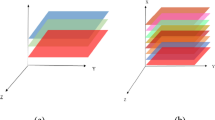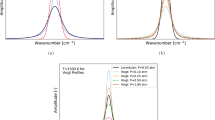Abstract
The Comprehensive Nuclear Test Ban Treaty allows for Multi-Spectral and Infrared Imaging from an aircraft and on the ground to help reduce the search area for an underground nuclear explosion from the initial 1,000 km2. Satellite data, primarily from Landsat, have been used as a surrogate for aircraft data to investigate whether there are any multi-spectral features associated with the nuclear tests in Pakistan, India or North Korea. It is shown that there are multi-spectral observables on the ground that can be associated with the nominal surface ground zero for at least some of these explosions, and that these are likely to be found by measurements allowed by the treaty.










Similar content being viewed by others
References
Barker, B., et al., “Monitoring Nuclear Tests”, Science, Vol. 281, 25 September 1998, pp. 1967–68.
Bras, R. L., Hampton, T., Coyne, J., Bobrov, D. and Zerbo, L., “CTBTO seismic processing and the announced DPRK nuclear test of October 9, 2006”, Geophysical Research Abstracts, Vol. 9, 07286, 2007.
Canty, M. J., Jasani, B., and Schlittenhardt, J., “Wide Area Change Detection with Satellite Imagery for Locating Underground Nuclear Testing”, Symposium on International Safeguards Verification and Nuclear Material Security 2001. IAEA publication IAEA-SM-367/16/02.
Canty 2001b Canty, M. J., Schlittenhardt, J., “Satellite data used to locate site of 1998 Indian nuclear test”, Eos Trans. AGU, 82(3), 25–29 (2001).
Canty, M. J., and Nielsen, A. A., “Visualization and unsupervised classification of changes in multispectral satellite imagery”, International Journal of Remote Sensing 27(18), 3961–3975 (2006).
Cong, X., Schlittenhardt, J., Gutjahr, K., Soergel, U., Canty, M., and Nielsen, A., “Using differential SAR interferometry for the measurement of surface displacement caused by underground nuclear explosions and comparison with optical change detection results”, Global Monitoring for Security and Stability (GMOSS) Integrated Scientific and Technological Research Supporting Security Aspects of the European Union (edited by G. Zeug & M. Pesaresi), European Commission - Joint Research Centre, 282–293 (2007).
CTBT 1996. Text of the Comprehensive Nuclear Test Ban Treaty, Protocol Paragraphs 69b and 80.
CTBTO 25 May 2009 press release. (http://www.ctbto.org/press-centre/press-releases/2009/ctbtos-initial-findings-on-the-dprks-2009-announced-nuclear-test/).
Eisler, J. D. and Chilton, F., “Spalling of the Earth’s Surface by Underground Nuclear Explosions,” Journal of Geophysical Research, Vol 69, No. 24, p5285, 1964.
Hall, G. E. M., Vaive, J. E., and Button, P., “Detection of past underground nuclear events by geochemical signatures in soils,” Journal of Geochemical Exploration, 1529 (1997).
Henderson, J. R., Primer on use of Multi-Spectral and Infra Red Imaging for On-Site Inspections, LLNL report LLNL-TR-463081, October 2010.
Jasani, B, “Could civil satellites monitor nuclear tests?”, Space Policy, February 1995, 11(1), pp 31–40.
Jasani, B, “Contribution of Remote Sensing Satellite to CTBT Verifiability”, Report of the Independent Committee on the Verifiability of the CTBT, Nov 2000. (http://www.ctbtcommission.org/jasanipaper.htm).
Jasani, B., and Canty, M., “Change detection methods applied to observation of nuclear tests by commercial remote sensing satellites”, 3rd Workshop on Science and modern technology for safeguards, 13-16 November 2000, Tokyo, Japan, Proceedings, European Communities, Report EUR 19943 EN, pp 189–97 (2001).
Malpica, J. A. and Alonso, M. C., “A method for change detection with multi-temporal satellite images using the RX algorithm”, The International Archives of the Photogrammetry, Remote Sensing and Spatial Information Sciences. Vol. XXXVII. Part B7. Beijing 2008.
Mitchley, M., Sears, M., and Damelin, S., “Target detection in hyperspectral mineral data using wavelet analysis”, IGARSS(4):881–884 (2009).
Myint, S., “A robust texture analysis and classification approach for urban land-use and land-cover feature discrimination”, Geocarto International, 16(4):27–38 (2001).
Nussbaum, S., Niemeyer, I., and Canter, M. J., “Feature recognition in the context of automated object-oriented analysis of remote sensing data monitoring Iranian nuclear sites,” Proc SPIE 5988 598805 (2005).
Pickles, W. L., Observations of Temporary Plant Stress Induced by the Surface Shock of a 1-kt Underground Chemical Explosion, LLNL, UCRL-ID-122557, December 1995.
Reed, I. S., and Yu, X., “Adaptive multiple-band CFAR detection of an optical pattern with unknown spectral distribution”, IEEE Transactions on Acoustics, Speech and Signal Processing, 38, pp. 1760–1770 (1990).
Rivard, B., Feng, J., Gallie, A., Sanchez-Azofeifa, “Continuous wavelets for the improved use of spectral libraries and hyperspectral data”, Remote Sensing of the Environment, 112: 2850–2862 (2008).
Rockett, P., “Multi-spectral Imaging in a CTBT OSI,” On-Site Inspection Workshop-5, November 1999.
Schlittenhardt, J., Canty, M., Grünberg, I. “Satellite Earth observations support CTBT monitoring: a case study of the nuclear test in North Korea of Oct. 9, 2006 and comparison with seismic results”, Pure Appl. Geophys., 167, 601–618, doi: 10.1007/s00024-009-0036-x (2010). http://www.springerlink.com/content/0t333072860x7521/.
Srinivas, A. and Wu, Y., “Multiresolution histograms for SVM-based texture classification”, Computer Science, 3656:754–761 (2005).
Subotic, N., Thelen, B., Gorman, J. and Reiley, M., “Multiresolution detection of coherent radar targets”, IEEE Trans. Image Processing Vol. 6, no.1, pp. 21–35 (1997).
Thomas, A., “Extending the RX anomaly detection algorithm to continuous spectral and spatial domains”, Proc. of IEEE Southeast Con, pp. 557–562 (2008).
Thyagarajan, K. and Patterson, R., “Systems and methods of using spatial/spectral/temporal imaging for hidden or buried explosive detection”, U.S. Patent Appl. No. 12/613,430 U.S. Pub. No. 2010/0166330 (2010).
Van der Werff, H. and Lucieer, A., “A contextual algorithm for detection of mineral alteration halos with hyperspectral remote sensing”, Remote Sensing Image Analysis: Including the spatial domain, Chapter 11, 201–210 (2006).
Vincent, P., Larsen, S., Galloway, D., Laczniak, R. J., Walter, W. R., Foxall, W., and Zucca, J. J., “New signatures of underground nuclear tests revealed by satellite radar interferometry”, Geophysical Research Letters, Vol. 30, NO. 22, 2141, doi:10.1029/2003GL018179, 2003.
Vincent, P., Buckley, S. M., Yang, D., and Carle, S. F., “Anomalous transient uplift observed at the Lop Nor,China nuclear test site using satellite radar interferometry time‐series analysis”, Geophysical Research Letters, Vol. 38, L23306, doi:10.1029/2011GL049302, 2011.
Wallace, T. C., 1998. “The May 1998 India and Pakistan Nuclear Tests”, Seismological Research Letters, September 1998.
Walter, W. R., Rodgers, A. J., Mayeda, K., Meyers, S. C., Pasyanos, M., and Denny, M., “Preliminary Regional Seismic Analysis of Nuclear Explosions and Earthquakes in Southwest Asia”, LLNL, UCRL-JC-130745, July 1998.
Zhang, X., Younan, N., and O’Hara, C., “Wavelet domain statistical hyperspectral soil texture classification”, IEEE Trans. Geosci. Remote Sens. Vol. 43, no. 3, pp. 615–618 (2005).
Acknowledgments
This work was performed under the auspices of the U.S. Department of Energy by Lawrence Livermore National Laboratory under Contract DE-AC52-07NA27344.
Author information
Authors and Affiliations
Corresponding author
Additional information
Disclaimer:
This document was prepared as an account of work sponsored by an agency of the United States government. Neither the United States government nor Lawrence Livermore National Security, LLC, nor any of their employees makes any warranty, expressed or implied, or assumes any legal liability or responsibility for the accuracy, completeness, or usefulness of any information, apparatus, product, or process disclosed, or represents that its use would not infringe privately owned rights. Reference herein to any specific commercial product, process, or service by trade name, trademark, manufacturer, or otherwise does not necessarily constitute or imply its endorsement, recommendation, or favoring by the United States government or Lawrence Livermore National Security, LLC. The views and opinions of authors expressed herein do not necessarily state or reflect those of the United States government or Lawrence Livermore National Security, LLC, and shall not be used for advertising or product endorsement purposes.
Rights and permissions
About this article
Cite this article
Henderson, J.R., Smith, M.O. & Zelinski, M.E. Overhead Detection of Underground Nuclear Explosions by Multi-Spectral and Infrared Imaging. Pure Appl. Geophys. 171, 763–777 (2014). https://doi.org/10.1007/s00024-012-0574-5
Received:
Revised:
Accepted:
Published:
Issue Date:
DOI: https://doi.org/10.1007/s00024-012-0574-5




